Abnormal Psychology: Classification, Diagnosis, and Influences of Heredity and Environment on Schizophrenia and Depression
VerifiedAdded on 2023/04/24
|8
|2194
|119
AI Summary
This paper discusses the primary methods that are used in classifying or defining mental illness. Moreover, the article will be discussing the influences of heredity and environment on schizophrenia and depression.
Contribute Materials
Your contribution can guide someone’s learning journey. Share your
documents today.
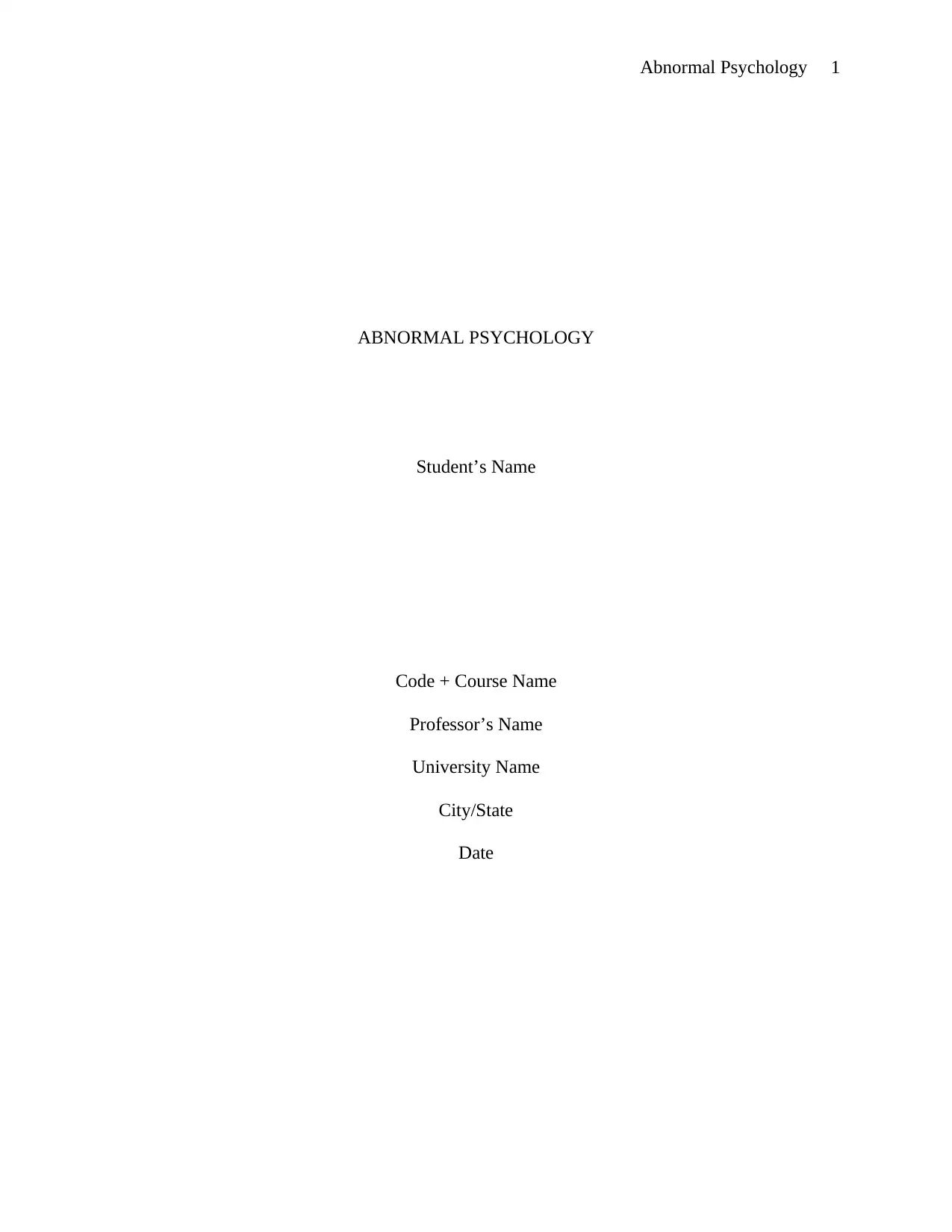
Abnormal Psychology 1
ABNORMAL PSYCHOLOGY
Student’s Name
Code + Course Name
Professor’s Name
University Name
City/State
Date
ABNORMAL PSYCHOLOGY
Student’s Name
Code + Course Name
Professor’s Name
University Name
City/State
Date
Secure Best Marks with AI Grader
Need help grading? Try our AI Grader for instant feedback on your assignments.
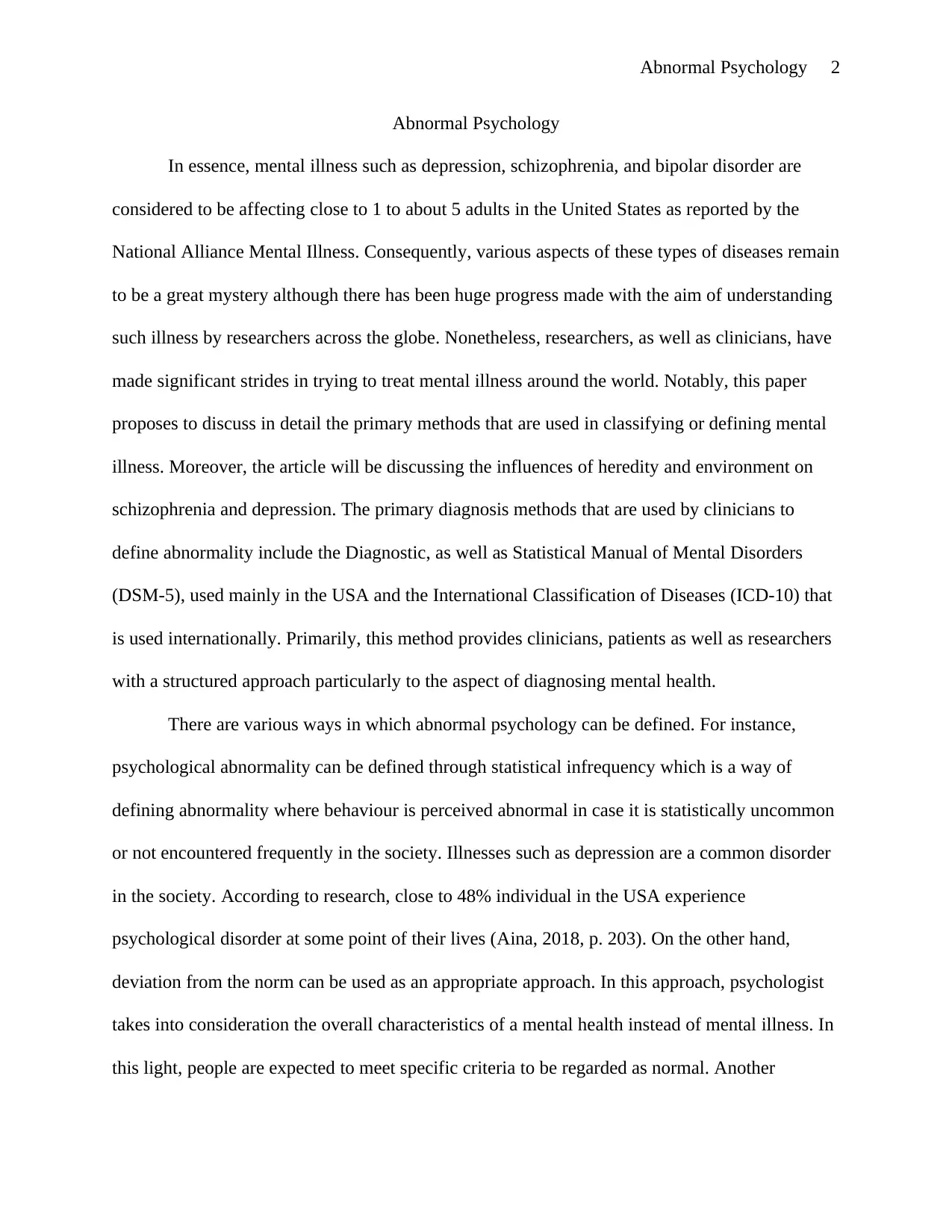
Abnormal Psychology 2
Abnormal Psychology
In essence, mental illness such as depression, schizophrenia, and bipolar disorder are
considered to be affecting close to 1 to about 5 adults in the United States as reported by the
National Alliance Mental Illness. Consequently, various aspects of these types of diseases remain
to be a great mystery although there has been huge progress made with the aim of understanding
such illness by researchers across the globe. Nonetheless, researchers, as well as clinicians, have
made significant strides in trying to treat mental illness around the world. Notably, this paper
proposes to discuss in detail the primary methods that are used in classifying or defining mental
illness. Moreover, the article will be discussing the influences of heredity and environment on
schizophrenia and depression. The primary diagnosis methods that are used by clinicians to
define abnormality include the Diagnostic, as well as Statistical Manual of Mental Disorders
(DSM-5), used mainly in the USA and the International Classification of Diseases (ICD-10) that
is used internationally. Primarily, this method provides clinicians, patients as well as researchers
with a structured approach particularly to the aspect of diagnosing mental health.
There are various ways in which abnormal psychology can be defined. For instance,
psychological abnormality can be defined through statistical infrequency which is a way of
defining abnormality where behaviour is perceived abnormal in case it is statistically uncommon
or not encountered frequently in the society. Illnesses such as depression are a common disorder
in the society. According to research, close to 48% individual in the USA experience
psychological disorder at some point of their lives (Aina, 2018, p. 203). On the other hand,
deviation from the norm can be used as an appropriate approach. In this approach, psychologist
takes into consideration the overall characteristics of a mental health instead of mental illness. In
this light, people are expected to meet specific criteria to be regarded as normal. Another
Abnormal Psychology
In essence, mental illness such as depression, schizophrenia, and bipolar disorder are
considered to be affecting close to 1 to about 5 adults in the United States as reported by the
National Alliance Mental Illness. Consequently, various aspects of these types of diseases remain
to be a great mystery although there has been huge progress made with the aim of understanding
such illness by researchers across the globe. Nonetheless, researchers, as well as clinicians, have
made significant strides in trying to treat mental illness around the world. Notably, this paper
proposes to discuss in detail the primary methods that are used in classifying or defining mental
illness. Moreover, the article will be discussing the influences of heredity and environment on
schizophrenia and depression. The primary diagnosis methods that are used by clinicians to
define abnormality include the Diagnostic, as well as Statistical Manual of Mental Disorders
(DSM-5), used mainly in the USA and the International Classification of Diseases (ICD-10) that
is used internationally. Primarily, this method provides clinicians, patients as well as researchers
with a structured approach particularly to the aspect of diagnosing mental health.
There are various ways in which abnormal psychology can be defined. For instance,
psychological abnormality can be defined through statistical infrequency which is a way of
defining abnormality where behaviour is perceived abnormal in case it is statistically uncommon
or not encountered frequently in the society. Illnesses such as depression are a common disorder
in the society. According to research, close to 48% individual in the USA experience
psychological disorder at some point of their lives (Aina, 2018, p. 203). On the other hand,
deviation from the norm can be used as an appropriate approach. In this approach, psychologist
takes into consideration the overall characteristics of a mental health instead of mental illness. In
this light, people are expected to meet specific criteria to be regarded as normal. Another

Abnormal Psychology 3
approach is the deviation from the social norms. Notably, abnormality is a form of illness where
an individual deviate from social norms (Aina, 2018, p. 203). People are labeled as abnormal in
case their behavior is different from what is accepted in the society.
Primarily, DSM-5 is regarded to be a manual that is used to assess and diagnose mental
disorders in patients. In essence, this method does not include specific information or rather
guidelines that are used for treating of any abnormality. In this light, determining an accurate
diagnosis is regarded as the main step towards treating any medical condition as well as mental
disorders. DSM-5 is, therefore, a valuable tool that can be used to measure the overall
effectiveness of any particular treatment because dimensional assessment often helps the
clinicians in the process of assessing various changes that may be encountered in the severity
levels as the primary response treatment (Rohde, Kieling, and Salum, 2018, p. 139). The main
reason why this method of diagnosis is currently or mainly used in the United States is that it is
compatible with the HIPAA-approved ICD 9-CM coding system that is often used by most
insurance companies in the USA.
Furthermore, ICD-10 is regarded to be an upgrade of the ICD that is a medical
classification list that is widely recognized by the World Health Organization. In essence, this
method mainly contains codes particularly for disease as well as signs and symptoms, abnormal
findings, and external causes especially of injury or even illnesses (Bickel, Crabbe, and Sher,
2019, p. 6). By the use of the classification, ICD-10 gives room for specificity particularly
concerning the cause, location, manifestation and various types of injuries in a patient. In this
light, the description as well as diagnostic guidelines particularly for the ICD-10 behavioral
disorders and mental illness. This method often defines the mental disorder to be a clinically set
of symptoms or rather behavior associated with distress and with a lot of interferences with
approach is the deviation from the social norms. Notably, abnormality is a form of illness where
an individual deviate from social norms (Aina, 2018, p. 203). People are labeled as abnormal in
case their behavior is different from what is accepted in the society.
Primarily, DSM-5 is regarded to be a manual that is used to assess and diagnose mental
disorders in patients. In essence, this method does not include specific information or rather
guidelines that are used for treating of any abnormality. In this light, determining an accurate
diagnosis is regarded as the main step towards treating any medical condition as well as mental
disorders. DSM-5 is, therefore, a valuable tool that can be used to measure the overall
effectiveness of any particular treatment because dimensional assessment often helps the
clinicians in the process of assessing various changes that may be encountered in the severity
levels as the primary response treatment (Rohde, Kieling, and Salum, 2018, p. 139). The main
reason why this method of diagnosis is currently or mainly used in the United States is that it is
compatible with the HIPAA-approved ICD 9-CM coding system that is often used by most
insurance companies in the USA.
Furthermore, ICD-10 is regarded to be an upgrade of the ICD that is a medical
classification list that is widely recognized by the World Health Organization. In essence, this
method mainly contains codes particularly for disease as well as signs and symptoms, abnormal
findings, and external causes especially of injury or even illnesses (Bickel, Crabbe, and Sher,
2019, p. 6). By the use of the classification, ICD-10 gives room for specificity particularly
concerning the cause, location, manifestation and various types of injuries in a patient. In this
light, the description as well as diagnostic guidelines particularly for the ICD-10 behavioral
disorders and mental illness. This method often defines the mental disorder to be a clinically set
of symptoms or rather behavior associated with distress and with a lot of interferences with
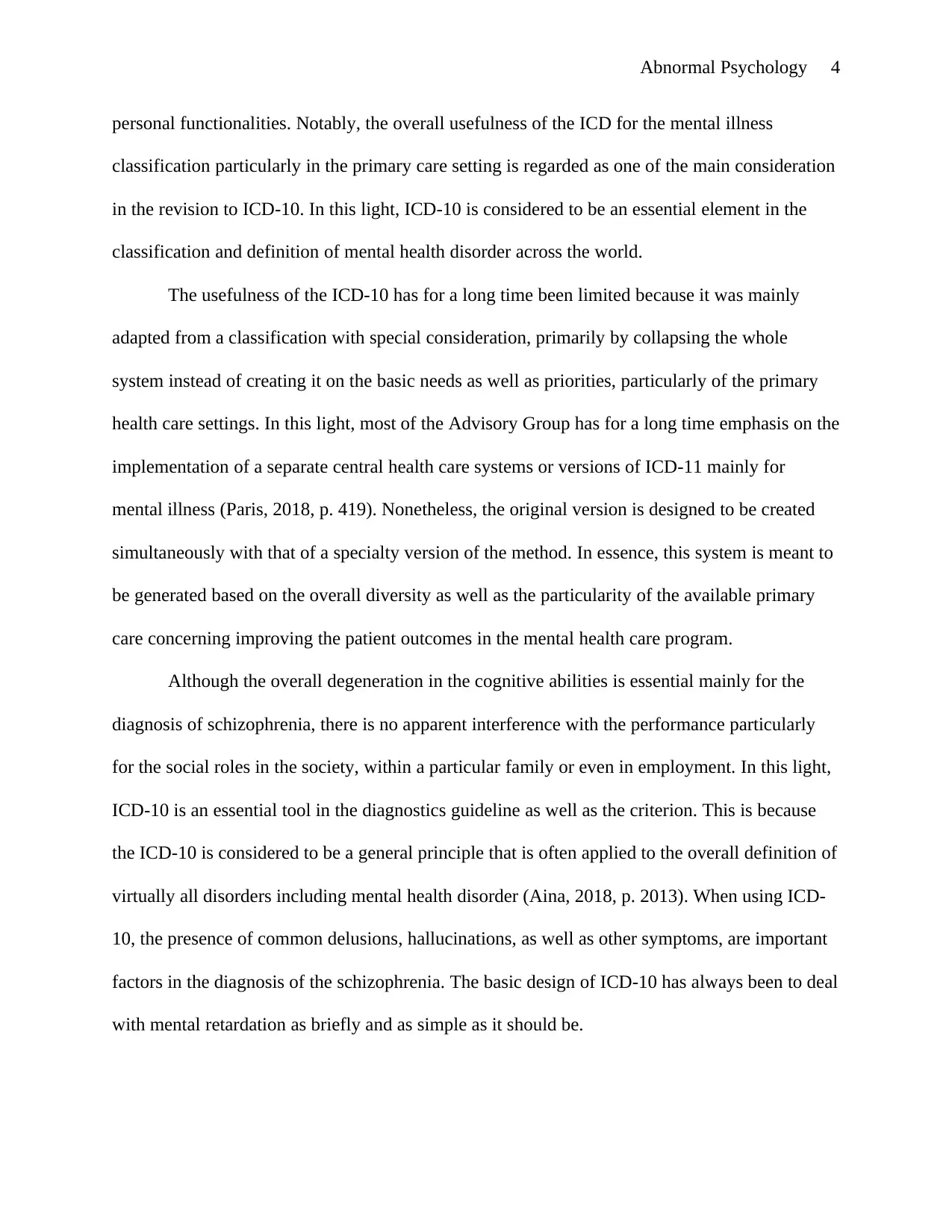
Abnormal Psychology 4
personal functionalities. Notably, the overall usefulness of the ICD for the mental illness
classification particularly in the primary care setting is regarded as one of the main consideration
in the revision to ICD-10. In this light, ICD-10 is considered to be an essential element in the
classification and definition of mental health disorder across the world.
The usefulness of the ICD-10 has for a long time been limited because it was mainly
adapted from a classification with special consideration, primarily by collapsing the whole
system instead of creating it on the basic needs as well as priorities, particularly of the primary
health care settings. In this light, most of the Advisory Group has for a long time emphasis on the
implementation of a separate central health care systems or versions of ICD-11 mainly for
mental illness (Paris, 2018, p. 419). Nonetheless, the original version is designed to be created
simultaneously with that of a specialty version of the method. In essence, this system is meant to
be generated based on the overall diversity as well as the particularity of the available primary
care concerning improving the patient outcomes in the mental health care program.
Although the overall degeneration in the cognitive abilities is essential mainly for the
diagnosis of schizophrenia, there is no apparent interference with the performance particularly
for the social roles in the society, within a particular family or even in employment. In this light,
ICD-10 is an essential tool in the diagnostics guideline as well as the criterion. This is because
the ICD-10 is considered to be a general principle that is often applied to the overall definition of
virtually all disorders including mental health disorder (Aina, 2018, p. 2013). When using ICD-
10, the presence of common delusions, hallucinations, as well as other symptoms, are important
factors in the diagnosis of the schizophrenia. The basic design of ICD-10 has always been to deal
with mental retardation as briefly and as simple as it should be.
personal functionalities. Notably, the overall usefulness of the ICD for the mental illness
classification particularly in the primary care setting is regarded as one of the main consideration
in the revision to ICD-10. In this light, ICD-10 is considered to be an essential element in the
classification and definition of mental health disorder across the world.
The usefulness of the ICD-10 has for a long time been limited because it was mainly
adapted from a classification with special consideration, primarily by collapsing the whole
system instead of creating it on the basic needs as well as priorities, particularly of the primary
health care settings. In this light, most of the Advisory Group has for a long time emphasis on the
implementation of a separate central health care systems or versions of ICD-11 mainly for
mental illness (Paris, 2018, p. 419). Nonetheless, the original version is designed to be created
simultaneously with that of a specialty version of the method. In essence, this system is meant to
be generated based on the overall diversity as well as the particularity of the available primary
care concerning improving the patient outcomes in the mental health care program.
Although the overall degeneration in the cognitive abilities is essential mainly for the
diagnosis of schizophrenia, there is no apparent interference with the performance particularly
for the social roles in the society, within a particular family or even in employment. In this light,
ICD-10 is an essential tool in the diagnostics guideline as well as the criterion. This is because
the ICD-10 is considered to be a general principle that is often applied to the overall definition of
virtually all disorders including mental health disorder (Aina, 2018, p. 2013). When using ICD-
10, the presence of common delusions, hallucinations, as well as other symptoms, are important
factors in the diagnosis of the schizophrenia. The basic design of ICD-10 has always been to deal
with mental retardation as briefly and as simple as it should be.
Secure Best Marks with AI Grader
Need help grading? Try our AI Grader for instant feedback on your assignments.
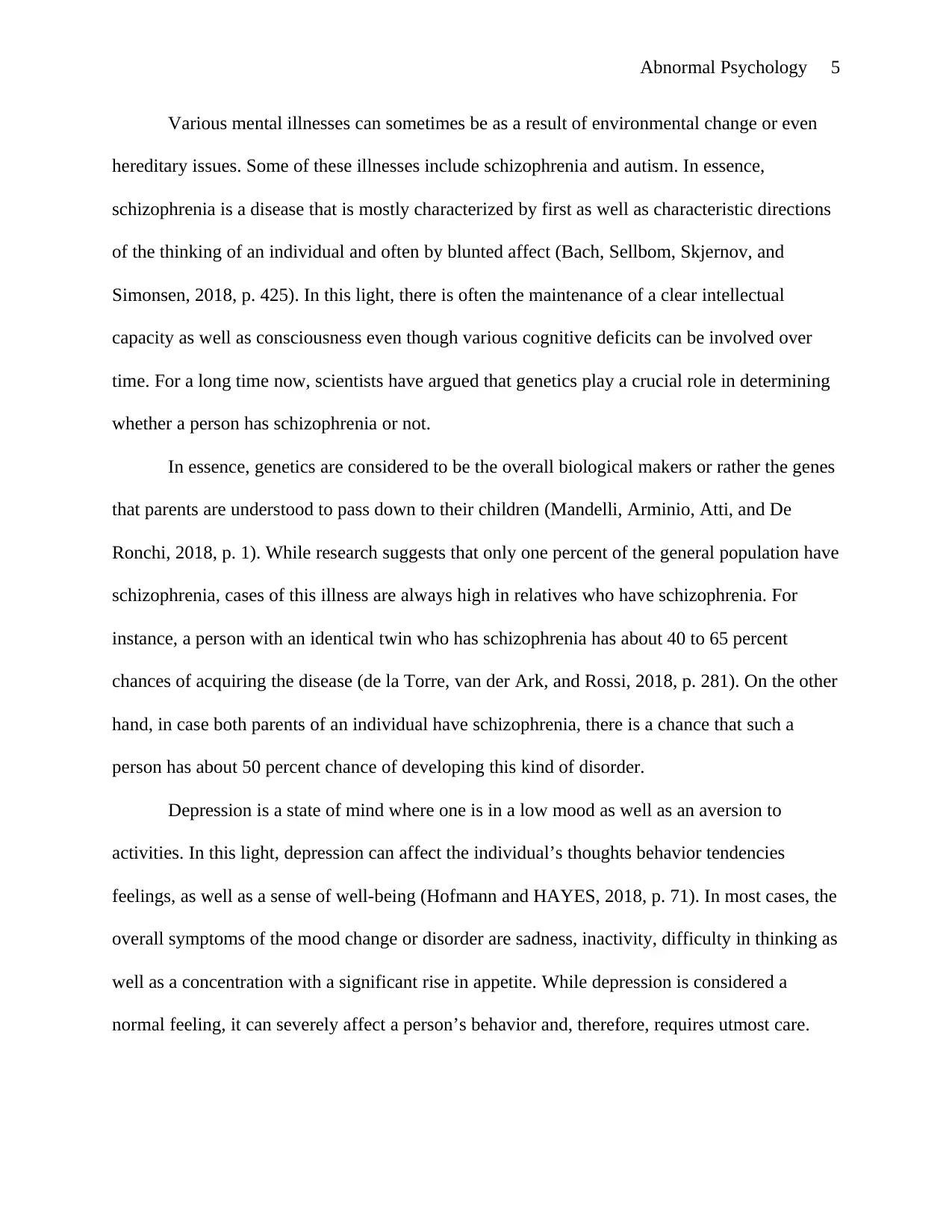
Abnormal Psychology 5
Various mental illnesses can sometimes be as a result of environmental change or even
hereditary issues. Some of these illnesses include schizophrenia and autism. In essence,
schizophrenia is a disease that is mostly characterized by first as well as characteristic directions
of the thinking of an individual and often by blunted affect (Bach, Sellbom, Skjernov, and
Simonsen, 2018, p. 425). In this light, there is often the maintenance of a clear intellectual
capacity as well as consciousness even though various cognitive deficits can be involved over
time. For a long time now, scientists have argued that genetics play a crucial role in determining
whether a person has schizophrenia or not.
In essence, genetics are considered to be the overall biological makers or rather the genes
that parents are understood to pass down to their children (Mandelli, Arminio, Atti, and De
Ronchi, 2018, p. 1). While research suggests that only one percent of the general population have
schizophrenia, cases of this illness are always high in relatives who have schizophrenia. For
instance, a person with an identical twin who has schizophrenia has about 40 to 65 percent
chances of acquiring the disease (de la Torre, van der Ark, and Rossi, 2018, p. 281). On the other
hand, in case both parents of an individual have schizophrenia, there is a chance that such a
person has about 50 percent chance of developing this kind of disorder.
Depression is a state of mind where one is in a low mood as well as an aversion to
activities. In this light, depression can affect the individual’s thoughts behavior tendencies
feelings, as well as a sense of well-being (Hofmann and HAYES, 2018, p. 71). In most cases, the
overall symptoms of the mood change or disorder are sadness, inactivity, difficulty in thinking as
well as a concentration with a significant rise in appetite. While depression is considered a
normal feeling, it can severely affect a person’s behavior and, therefore, requires utmost care.
Various mental illnesses can sometimes be as a result of environmental change or even
hereditary issues. Some of these illnesses include schizophrenia and autism. In essence,
schizophrenia is a disease that is mostly characterized by first as well as characteristic directions
of the thinking of an individual and often by blunted affect (Bach, Sellbom, Skjernov, and
Simonsen, 2018, p. 425). In this light, there is often the maintenance of a clear intellectual
capacity as well as consciousness even though various cognitive deficits can be involved over
time. For a long time now, scientists have argued that genetics play a crucial role in determining
whether a person has schizophrenia or not.
In essence, genetics are considered to be the overall biological makers or rather the genes
that parents are understood to pass down to their children (Mandelli, Arminio, Atti, and De
Ronchi, 2018, p. 1). While research suggests that only one percent of the general population have
schizophrenia, cases of this illness are always high in relatives who have schizophrenia. For
instance, a person with an identical twin who has schizophrenia has about 40 to 65 percent
chances of acquiring the disease (de la Torre, van der Ark, and Rossi, 2018, p. 281). On the other
hand, in case both parents of an individual have schizophrenia, there is a chance that such a
person has about 50 percent chance of developing this kind of disorder.
Depression is a state of mind where one is in a low mood as well as an aversion to
activities. In this light, depression can affect the individual’s thoughts behavior tendencies
feelings, as well as a sense of well-being (Hofmann and HAYES, 2018, p. 71). In most cases, the
overall symptoms of the mood change or disorder are sadness, inactivity, difficulty in thinking as
well as a concentration with a significant rise in appetite. While depression is considered a
normal feeling, it can severely affect a person’s behavior and, therefore, requires utmost care.
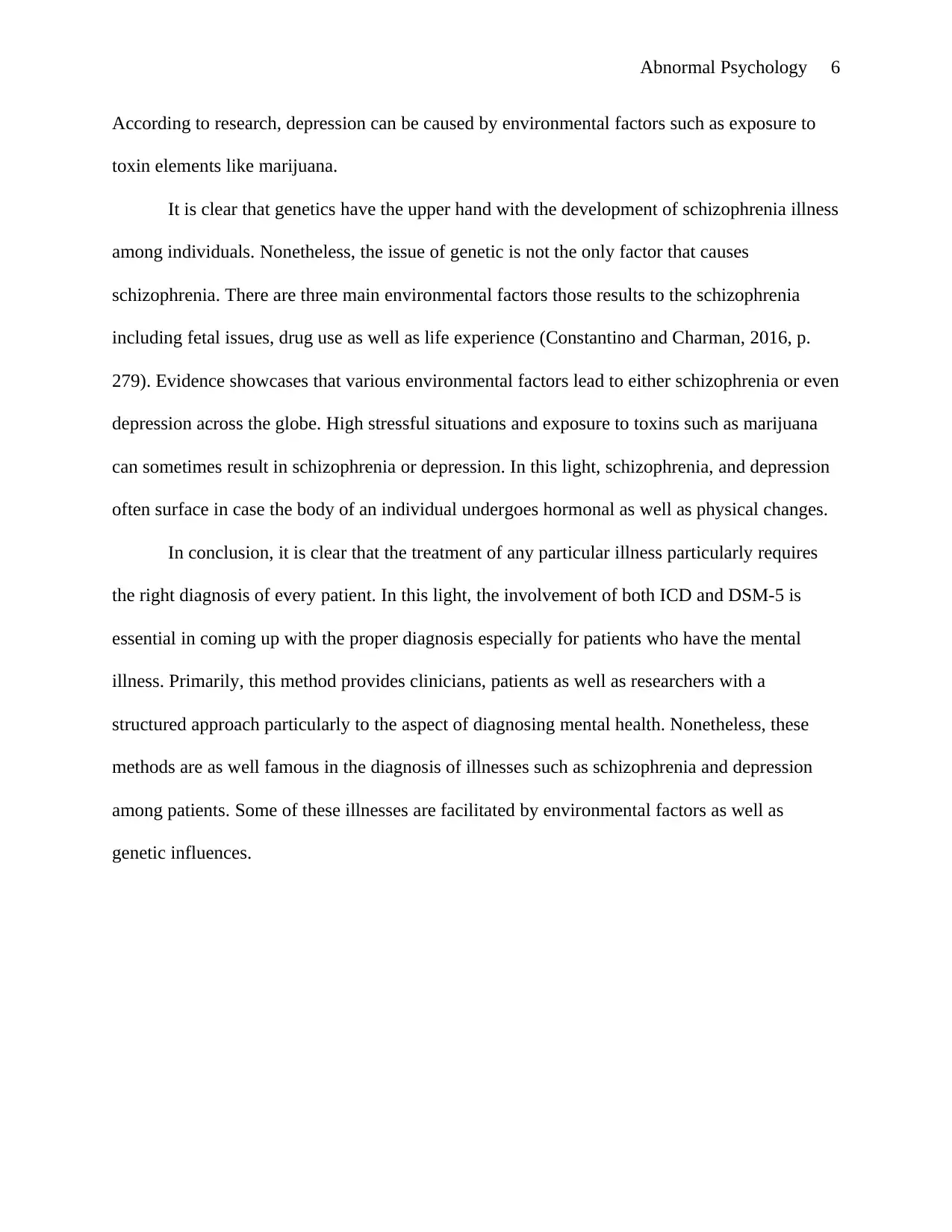
Abnormal Psychology 6
According to research, depression can be caused by environmental factors such as exposure to
toxin elements like marijuana.
It is clear that genetics have the upper hand with the development of schizophrenia illness
among individuals. Nonetheless, the issue of genetic is not the only factor that causes
schizophrenia. There are three main environmental factors those results to the schizophrenia
including fetal issues, drug use as well as life experience (Constantino and Charman, 2016, p.
279). Evidence showcases that various environmental factors lead to either schizophrenia or even
depression across the globe. High stressful situations and exposure to toxins such as marijuana
can sometimes result in schizophrenia or depression. In this light, schizophrenia, and depression
often surface in case the body of an individual undergoes hormonal as well as physical changes.
In conclusion, it is clear that the treatment of any particular illness particularly requires
the right diagnosis of every patient. In this light, the involvement of both ICD and DSM-5 is
essential in coming up with the proper diagnosis especially for patients who have the mental
illness. Primarily, this method provides clinicians, patients as well as researchers with a
structured approach particularly to the aspect of diagnosing mental health. Nonetheless, these
methods are as well famous in the diagnosis of illnesses such as schizophrenia and depression
among patients. Some of these illnesses are facilitated by environmental factors as well as
genetic influences.
According to research, depression can be caused by environmental factors such as exposure to
toxin elements like marijuana.
It is clear that genetics have the upper hand with the development of schizophrenia illness
among individuals. Nonetheless, the issue of genetic is not the only factor that causes
schizophrenia. There are three main environmental factors those results to the schizophrenia
including fetal issues, drug use as well as life experience (Constantino and Charman, 2016, p.
279). Evidence showcases that various environmental factors lead to either schizophrenia or even
depression across the globe. High stressful situations and exposure to toxins such as marijuana
can sometimes result in schizophrenia or depression. In this light, schizophrenia, and depression
often surface in case the body of an individual undergoes hormonal as well as physical changes.
In conclusion, it is clear that the treatment of any particular illness particularly requires
the right diagnosis of every patient. In this light, the involvement of both ICD and DSM-5 is
essential in coming up with the proper diagnosis especially for patients who have the mental
illness. Primarily, this method provides clinicians, patients as well as researchers with a
structured approach particularly to the aspect of diagnosing mental health. Nonetheless, these
methods are as well famous in the diagnosis of illnesses such as schizophrenia and depression
among patients. Some of these illnesses are facilitated by environmental factors as well as
genetic influences.
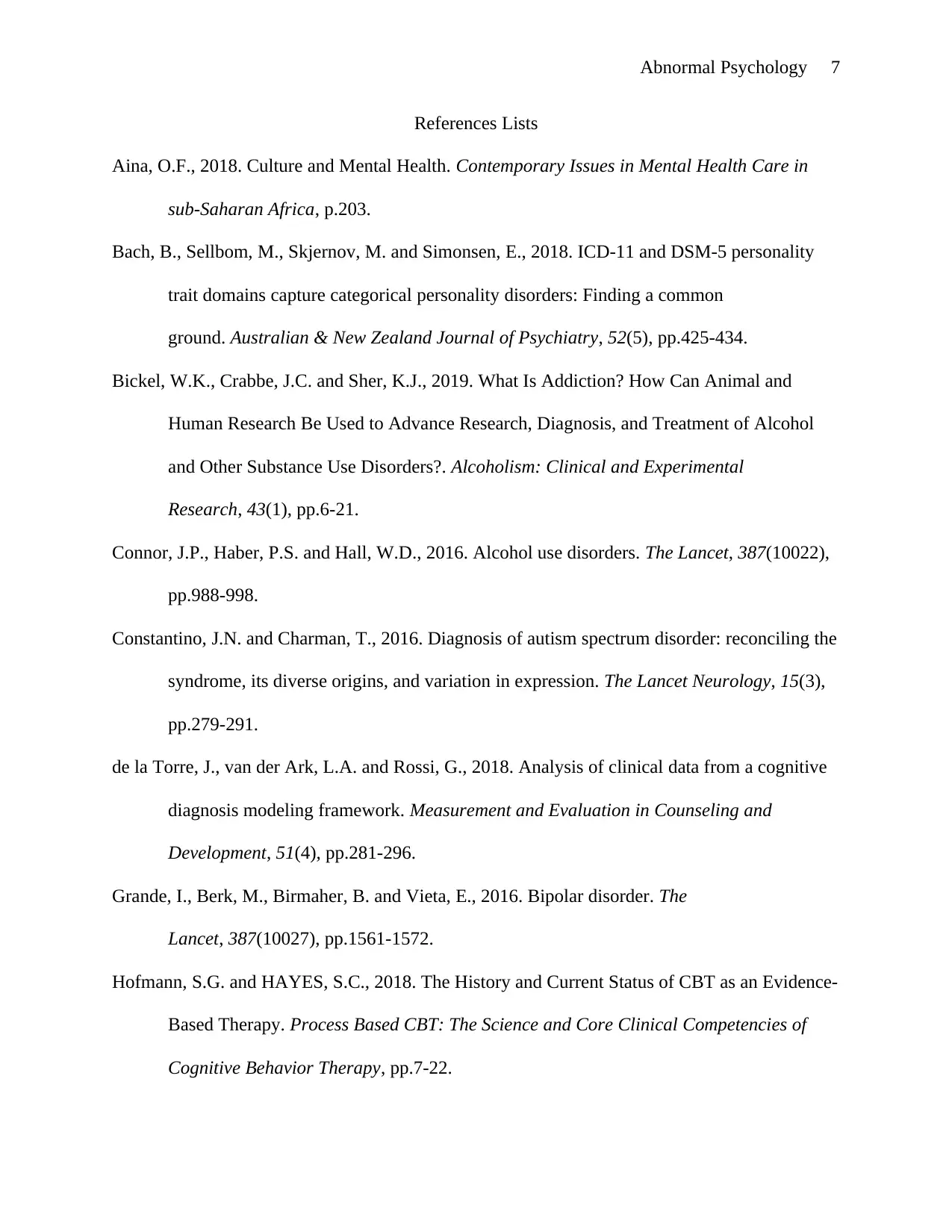
Abnormal Psychology 7
References Lists
Aina, O.F., 2018. Culture and Mental Health. Contemporary Issues in Mental Health Care in
sub-Saharan Africa, p.203.
Bach, B., Sellbom, M., Skjernov, M. and Simonsen, E., 2018. ICD-11 and DSM-5 personality
trait domains capture categorical personality disorders: Finding a common
ground. Australian & New Zealand Journal of Psychiatry, 52(5), pp.425-434.
Bickel, W.K., Crabbe, J.C. and Sher, K.J., 2019. What Is Addiction? How Can Animal and
Human Research Be Used to Advance Research, Diagnosis, and Treatment of Alcohol
and Other Substance Use Disorders?. Alcoholism: Clinical and Experimental
Research, 43(1), pp.6-21.
Connor, J.P., Haber, P.S. and Hall, W.D., 2016. Alcohol use disorders. The Lancet, 387(10022),
pp.988-998.
Constantino, J.N. and Charman, T., 2016. Diagnosis of autism spectrum disorder: reconciling the
syndrome, its diverse origins, and variation in expression. The Lancet Neurology, 15(3),
pp.279-291.
de la Torre, J., van der Ark, L.A. and Rossi, G., 2018. Analysis of clinical data from a cognitive
diagnosis modeling framework. Measurement and Evaluation in Counseling and
Development, 51(4), pp.281-296.
Grande, I., Berk, M., Birmaher, B. and Vieta, E., 2016. Bipolar disorder. The
Lancet, 387(10027), pp.1561-1572.
Hofmann, S.G. and HAYES, S.C., 2018. The History and Current Status of CBT as an Evidence-
Based Therapy. Process Based CBT: The Science and Core Clinical Competencies of
Cognitive Behavior Therapy, pp.7-22.
References Lists
Aina, O.F., 2018. Culture and Mental Health. Contemporary Issues in Mental Health Care in
sub-Saharan Africa, p.203.
Bach, B., Sellbom, M., Skjernov, M. and Simonsen, E., 2018. ICD-11 and DSM-5 personality
trait domains capture categorical personality disorders: Finding a common
ground. Australian & New Zealand Journal of Psychiatry, 52(5), pp.425-434.
Bickel, W.K., Crabbe, J.C. and Sher, K.J., 2019. What Is Addiction? How Can Animal and
Human Research Be Used to Advance Research, Diagnosis, and Treatment of Alcohol
and Other Substance Use Disorders?. Alcoholism: Clinical and Experimental
Research, 43(1), pp.6-21.
Connor, J.P., Haber, P.S. and Hall, W.D., 2016. Alcohol use disorders. The Lancet, 387(10022),
pp.988-998.
Constantino, J.N. and Charman, T., 2016. Diagnosis of autism spectrum disorder: reconciling the
syndrome, its diverse origins, and variation in expression. The Lancet Neurology, 15(3),
pp.279-291.
de la Torre, J., van der Ark, L.A. and Rossi, G., 2018. Analysis of clinical data from a cognitive
diagnosis modeling framework. Measurement and Evaluation in Counseling and
Development, 51(4), pp.281-296.
Grande, I., Berk, M., Birmaher, B. and Vieta, E., 2016. Bipolar disorder. The
Lancet, 387(10027), pp.1561-1572.
Hofmann, S.G. and HAYES, S.C., 2018. The History and Current Status of CBT as an Evidence-
Based Therapy. Process Based CBT: The Science and Core Clinical Competencies of
Cognitive Behavior Therapy, pp.7-22.
Paraphrase This Document
Need a fresh take? Get an instant paraphrase of this document with our AI Paraphraser
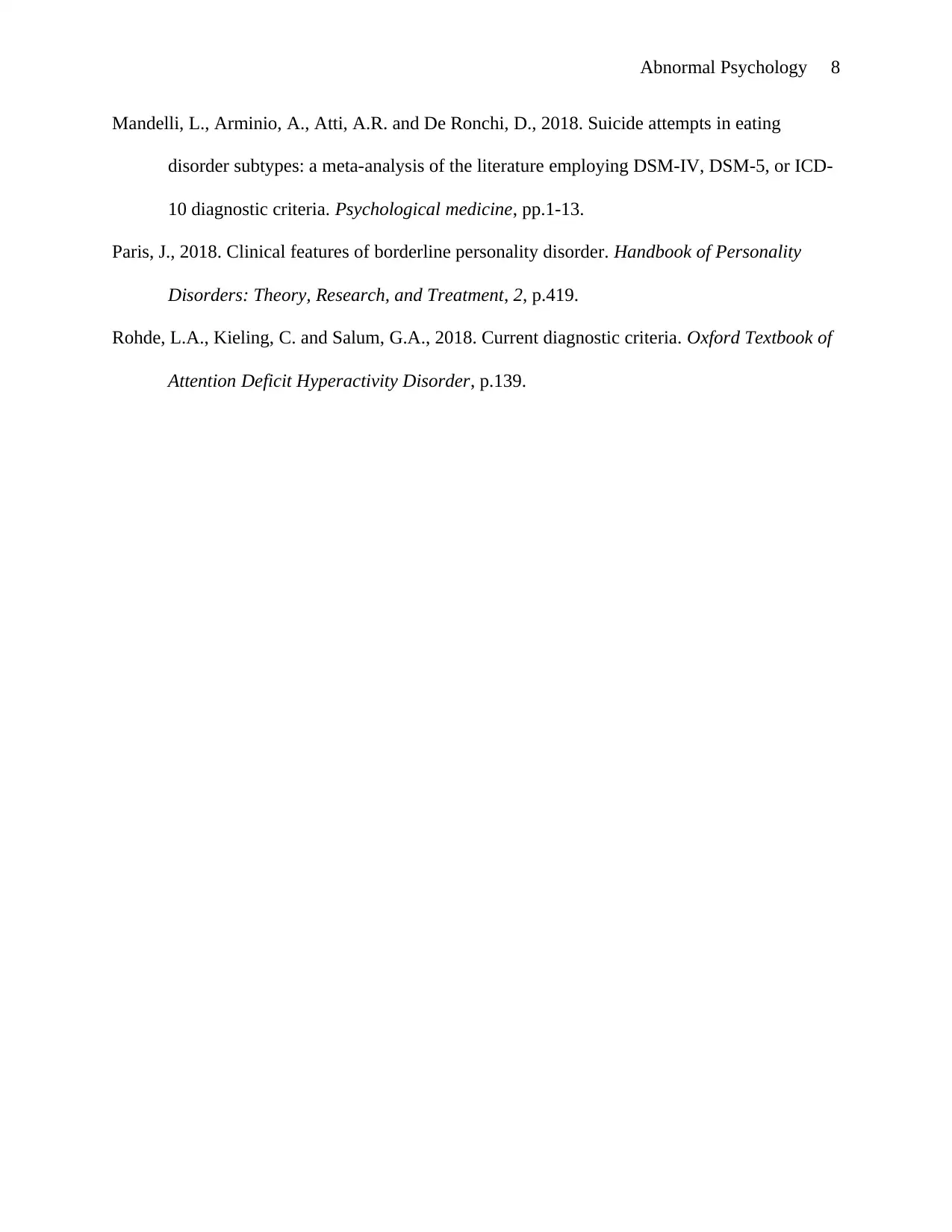
Abnormal Psychology 8
Mandelli, L., Arminio, A., Atti, A.R. and De Ronchi, D., 2018. Suicide attempts in eating
disorder subtypes: a meta-analysis of the literature employing DSM-IV, DSM-5, or ICD-
10 diagnostic criteria. Psychological medicine, pp.1-13.
Paris, J., 2018. Clinical features of borderline personality disorder. Handbook of Personality
Disorders: Theory, Research, and Treatment, 2, p.419.
Rohde, L.A., Kieling, C. and Salum, G.A., 2018. Current diagnostic criteria. Oxford Textbook of
Attention Deficit Hyperactivity Disorder, p.139.
Mandelli, L., Arminio, A., Atti, A.R. and De Ronchi, D., 2018. Suicide attempts in eating
disorder subtypes: a meta-analysis of the literature employing DSM-IV, DSM-5, or ICD-
10 diagnostic criteria. Psychological medicine, pp.1-13.
Paris, J., 2018. Clinical features of borderline personality disorder. Handbook of Personality
Disorders: Theory, Research, and Treatment, 2, p.419.
Rohde, L.A., Kieling, C. and Salum, G.A., 2018. Current diagnostic criteria. Oxford Textbook of
Attention Deficit Hyperactivity Disorder, p.139.
1 out of 8
Your All-in-One AI-Powered Toolkit for Academic Success.
+13062052269
info@desklib.com
Available 24*7 on WhatsApp / Email
![[object Object]](/_next/static/media/star-bottom.7253800d.svg)
Unlock your academic potential
© 2024 | Zucol Services PVT LTD | All rights reserved.





